VASELINE GLASS
"The pieces of miniature glassware of the late nineteenth and early twentieth
century are more than objects of art. They represent a longed-for, bygone time --
a time before synthetic materials . . . a time when skilled craftsmen left their marks
in hand-etched glass . . . a time when a child's future dreams were as bright as
the reflections of a prism."
(from jacket cover of CHILDREN'S GLASS DISHES by Doris Lechler & Virginia O'Neill, Copyright 1976 by Thomas Nelson, Inc., Publishers)
The following pieces, all made from vaseline glass, are just a small subset of a much larger
collecting interest by collectors who have an interest in MINIATURE AND CHILDREN'S glass. Several books have
been written about the subject, and there is a collector organization known as
TREASURES FOR LITTLE CHILDREN
that specialize in Children's dishes, Toy Glass, Miniature Furniture, Dollhouses and related toys.
None of the glass shown below is for sale and is for your enjoyment only.
All pictures are copyrighted by Dave Peterson (Mr. Vaseline Glass)
If you have knowledge of any specific names that are missing from any
of these photos, please contact me at> davepeterson8 [at] gmail.com
ALL PHOTOS CAN BE CLICKED FOR LARGER IMAGES!
This is the newest edition to this collection. It is a toy Ewer & Basin
and most likely made in England, about 1850-1880. The two pieces
are flint glass with a high lead content. The pitcher measures 3 1/4" tall
and the basin is 3 7/8" maximum top rim diameter. The package
of gum gives a visual aid as to the smallness of this set.
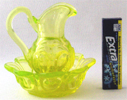
This half-size two-piece table epergne is 8 3/4" tall by 6" wide.
The top horn fits into a hole in the center of the base. It was
made in a variety of colors by Vallerysthal and is called RIBS & SCALLOPS.

This bear is called MUZZLED BEAR POMADE JAR
and was made by Boston & Sandwich 1845-1870. This is
the smallest of 4 sizes. It's original use was bear grease
pomade, a hair treatment. The piece is usually damaged,
as the top was glued to the base and had to be pried
apart with a knife. The bear was made in a dark
(looks black) amethyst (the most common),
fiery opalescent, milk glass, opaque blue, and
canary (vaseline). The scarcest, by far, is the vaseline.
(I am still searching for the proper top for my Bear!)
This bear is 3 1/2" tall.

This toy bucket was made in England and the color
is called 'rubina verde opalescent'. There is an inside
layer of cranberry and an outer ribbed layer of
vaseline opalescent glass. The glass insert stands 3 1/4".
the frame is marked EPNS (electroplate nickel silver).
This was made circa 1880s-1900s. Maker is unknown.

This toy bucket was also made in England. The color
is vaseline opalescent. It is shown (without the metalwork) in
Edwards/Carwile book on Opalescent Glass as
ROLLED WIDE STRIPE. It was most likely a match holder,
as the glass is 2 1/2" tall. No doubt, they had alternate uses
by those with little hands!

This is one very fancy toy spoon! I have shown two different
views, both showing natural light and UV light. The custom
stand was made of an exotic hardwood. The spoon has a cup and
stem made from vaseline glass, with a milk glass ball attached
at the end. The stem also has a barber-pole motif of red and blue
glass that is wrapped end to end. The spoon is 4" in length.

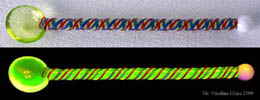
This novelty swan is an odd color of uranium glass. It also
has a 'lemon squeezer' foot, called that way because of
it's shape. This swan has a pressed base, and was attached
to the top portion by a wafer of glass. It is circa 1820-30. It's
original use could have been as a open salt dish. I have also
seen these in a cobalt blue and a forest green. This is
the only one in this color that seems to have surfaced
in the collector world. Height is 5", foot is 2 1/4".
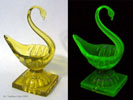
These are two rare children's mugs in vaseline glass.
On the left is "No. 15 Toy Mug (aka: ALPHABET & CHILDREN)
and was made by Adams and Co., early 1880s. The second
photo link shows all three sides and an original catalog illustration.
The mug on the right is about 20 years older than the Adams
mug and was made by Greener & Co., England. The mold work
is rough and the seam lines are prominent. The Adams mug
is 2 5/8" tall. The Greener mug is 2 7/8" tall.
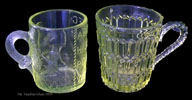
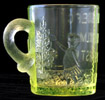
This toy lemonade set was made by Hobbs, Brockunier & Co.
and was first introduced in March 1886. The original pattern is called
DEW DROP and is now generically called Hobnail. Five different sizes
of pitchers were made. The smallest size was called "size 0"
and was made for the toy lemonade set. It stands approx. 3 3/4" to 3 7/8" tall.
The 'tumblers' were marked to adults as toothpick holders, and
were sold as tumblers for the toy lemonade set. They are
2 1/4" tall. The pitcher is canary opalescent, the tumblers
are bright canary. UPDATE: A VASELINE OPALESCENT TUMBLER
HAS BEEN ADDED TO THIS SET! THIS TUMBLER IS EXTREMELY RARE!
The color varies from tumbler to tumbler in the bright canary versions (on platform)
and some are smooth on the bottom and some have hobnails.
All are original.

This child's mug is called BIRD IN NEST WITH FLOWERS.
According to PATTERN GLASS MUGS by Mordock & Adams,
it was only made in clear and slag. The slag versions have
a star-shape on the bottom. I have not seen a clear one, but
the reference lists a cat on the bottom. This vaseline version
also has the cat on the bottom, which can be seen when the
child finishes drinking the milk. Height is 3 3/8". This piece
was made by Challinor & Taylor in the 1880s. The two sides of
the mug have different views, which are shown in the photo.

These two dishes may have been marketed as open
salt dishes, but few survive, due to their iresistibility to
little boys! They were made by Adams & Co. and
were made in clear, clear frosted, blue, amber and canary.
A larger size was also made in the same pattern, but
has only been found in clear. The photo shows canary
and amber versions. Length: 4", height 2". The wheels
are pewter on all models.
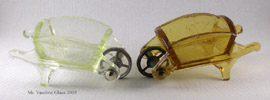
This trumpet or bugle was made by glassworkers in England
and they were used when the glassworkers marched in a parade.
The glass has a slight tint of opalescence at the mouthpiece.
The spiral wrap is called 'wrythen'. The piece also has a high
lead content, and when flicked, has a sustained bell-tone. No
molds were used to make these horns, and I have seen them in
this color, clear, and cobalt blue. I have also seen them with more
than one coil. Yes, noise can actually be made by blowing on it!
Standing on end, it can also be used for a bud vase! In the US,
off-hand work like this is called a 'whimsey' and in England,
they were known as 'friggers'. Length is 9 1/2" on this version.
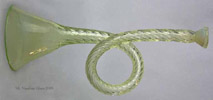
This is a toy spooner or 'spill' in vaseline glass, circa 1850s.
Similar versions were made at Boston & Sandwich Glass Co.,
but it is believed this one is most likely English or Bohemian.
Height is almost 2 1/2".

This toy OWL creamer is an odd shade of uranium glass.
It was most likely made by Richards & Hartley Glass, circa 1880s.
The mold work on the feathers, beak, eyes, etc, is very detailed.
No other matching pieces were made with this item.
Height is 3 5/8"
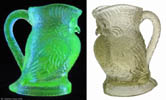
This is the smallest piece of vaseline glass in my collection.
It could accurately be called a 'dollhouse' pitcher. It has an
attached red glass handle. Height is 5/8" and top rim is 3/4" diameter.
Maker unknown and a contemporary piece.
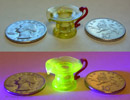
This little creamer and sugar set could be an individual
set for a breakfast table, or it might be children's glass.
The sugar bowl, when found by itself, usually is marketed
as an open salt. The set is English, about 1860s, and is
made from flint (leaded) glass. The creamer handle is attached
after the mold work was completed. Because of the style
of the gadroons around the top of the creamer, many believe
this might be a product of Edward Moore & Co., who made
similar designs. Height of creamer: 2 1/4", Height of sugar: 1 3/4"
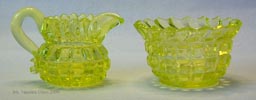
These two piggies are just plain cute! The one on the
right was made by Thomas Webb & Sons in 1908 at the
Franco British Exhibition. They were made on-site and
sold as souvenirs. The Webb pig is solid glass. The Broadfield House
Museum in Dudley, England, as one with an original box.
The one on the left is hollow, with an opening at the rear.
When found, most have damage. Both of these are missing
part of one ear. Left pig: 4" long. Webb pig: 2 3/4" long.

These four pieces are contemporary, but are interesting
enough to add to this grouping. The large dog on the left
is POOCH and was made by Boyd Glass, and before
that, was made by Degenhart. The two little dogs on the
couch were made by Mosser for the Degenhart Museum
in Cambridge, OH. The maker of the advertisement
piece, "CHAIRCRAFT" is unknown. the company is
still in existence, but so far, have not responded to inquries.
I display it like this in my home.
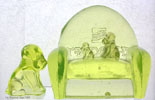
This little basket is Victorian from the Stourbridge
region of England. The maker is not known.
The main portion of the basket is cased glass with white
on the outside, cranberry on the inside. The handle
and base are vaseline glass. The total height is 3 3/4"
and to the top of the cranberry portion is 2 3/8".
The maker is unknown.
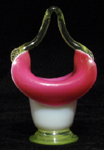
This toy cakestand is just 3 3/8" tall, with a top diameter
of 4 1/2". This is marked Baccarat Depose in a circular marking
on the top of the cake stand in the center ring. Original purpose is unknown,
but has been seen in several larger sizes.
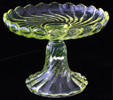
Come back again.....More to be added!